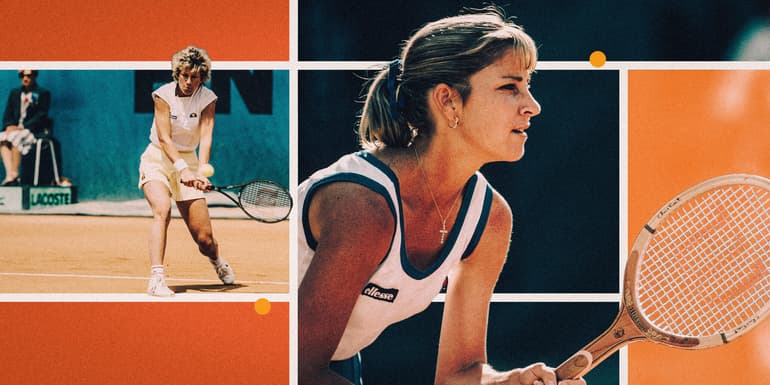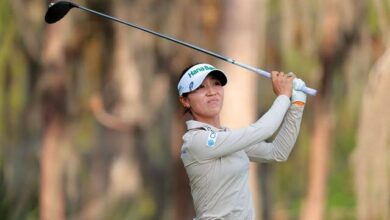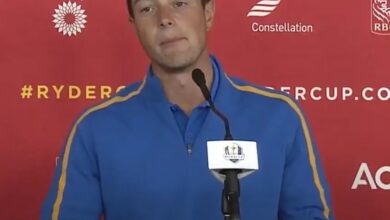Chris Evert interview: How an American tennis legend made the French Open her home

Chris Evert has been through a lot of life lately; the terrible and the beautiful. A second round of treatments for ovarian cancer dominated the first half of her year, before a first grandchild, Hayden James, was born late last month. She was out in Colorado with her son’s family during the first week of the French Open, but then she did a weekend at home and caught a flight to Paris and a cab to Roland Garros.
This is where it all started, 50 years ago in 1974, back when Evert was a 19-year-old phenom with the blonde ponytail and rock-solid forehand that nearly every American girl who picked up a tennis racket desperately craved — for some, the pin-straight hair even more than the forehand.
By the time she was done, 15 years later, Evert had won the French Open seven times, more than any player in the modern era besides Rafael Nadal. She spent 260 weeks as world No 1, won 18 Grand Slam titles in all and finished with a clay-court match record of 382-22, a 94.55 percent win-rate; the best women’s clay-court player of all time.
That makes it slightly bewildering that she doesn’t really think of herself as comparable to the players of today. She’s wrong about that, even as the modern version of Evert, Iga Swiatek, is steaming toward her fourth French Open title in five years. A new queen of clay, whose reign also started at 19.
But perhaps more bewildering is that, on the 50th anniversary of her first entry into the pantheon of tennis, Evert is more preoccupied with something that happened 51 years ago. In the 1973 French Open final against Margaret Court, she split the first two sets in tiebreaks but Court beat her in the third, 6-4.
“I was up a set and then had a break in the third,” Evert said during a recent interview from her home in Florida, very much over it, but still a bit curious about what unfolded that day.
“How did I lose that?”
Maybe because she was 18, still evolving into adulthood, and playing a 30-year-old veteran who had won 22 Grand Slam titles already.
Evert said she still felt mostly like a girl back then, especially physically. She said she would put on her dress, and her earrings, and tie her hair in a ponytail before taking the court against these fully-fledged grown-ups in tennis, and in life, that she shared a locker room with. Then she left the locker room.
“On the court, on clay, I felt like no one was going to beat me,” Evert said.
More than just about any sport, women’s tennis has long been the one where a teenager could make her mark. That pretty much started with Evert, who beat Court when she was just 15 years old and made the U.S. Open semifinals at 16. Before the end of her career, she would learn what that felt like to be on the other side of the equation, losing to Monica Seles when Seles was 15.
She still turned the numbers in her favor. A year after that loss to Court, Evert walked back onto the stadium court at Roland Garros to play Olga Morozova of the Soviet Union. Evert was still the kid with the ponytail. Morozova was five years older. But it didn’t matter. It was a pasting: 6-1, 6-2.
Winning in Paris, even after that defeat to Court that she still thinks about today, came easily to Evert, and she understands it today just as she understood it then. In the early 1970s, three of the four Grand Slams took place on grass courts, the domain of serve-and-volley tennis.
Evert, like Coco Gauff today, grew up in Florida, honing her game on the green clay of public courts near her home.
“I had so much more confidence playing at the French Open than anywhere else,” she said.
Her opponents would come to the net, as they always did, and try to end points in three or four shots, as they always did.
Evert hung at the baseline and pounded them until they wilted.
Nearly every time she walked onto the clay, a series of thoughts would run through her head.
“This is the surface I grew up on. It suits me perfectly. No one can overpower me. No one can blow me off the court. I am more patient than anyone. I’m going to hit with depth and placement and just wear them down.”
That’s exactly what she did, on that day in 1974, and six times more.
To hear Evert talk about those first years in Paris in the 1970s, is to be transported to another time.
“It was 50 freaking years ago,” she nearly screams into the phone.
Philippe Chatrier, the president of the International Tennis Federation whose name is now on the Roland Garros stadium court, took Evert and her mother out to dinner one night. They went to The Lido, where the waitresses worked topless. “Interesting choice,” said Evert, who had never been to a topless establishment of any sort before.
The talk of the tournament was a hot young Swedish guy named Bjorn Borg, who was fast becoming the sport’s first superstar. Girls screamed for him when he appeared, the way they’d screamed for The Beatles. Borg won his first French Open that year, too, an equal champion to Evert.
She said she was too embarrassed to talk to him.
Ensuing years at Roland Garros went by with those same thoughts on-court, that this was her place, that it couldn’t be taken from her. Evert thinks maybe she got a little overconfident there for a bit, “coasted” for a little while even — for 10 years between 1974 and 1984, she won five of her seven French Opens. There were gaps in between, but not because she was getting beaten. She just wasn’t playing. Sometimes she chose the payday of playing World Team Tennis, her friend Billie Jean King’s mixed-team event, instead.
Then, in 1984, her tennis soulmate Martina Navratilova kicked it up a notch. Evert was finally beaten in a French Open final, and comprehensively too, 6-3, 6-1. Evert and every player of that era has spoken of Navratilova taking the sport to a new level with her focus on fitness, diet and that drive backhand. They had a choice: do what she was doing, or go away. Evert followed Navratilova’s lead.



